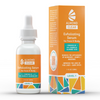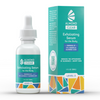Why Mandelic Acid is a Great Solution to Hyperpigmentation-prone Skin
Struggling with hyperpigmentation and uneven skin tone can be a confidence killer. If you've tried various skincare products with little to no success, it's time to discover a game-changer: mandelic acid. This gentle yet effective alpha hydroxy acid (AHA) is a proven solution for brightening hyperpigmentation and evening out skin tone.
What is Mandelic Acid?
Mandelic acid, derived from bitter almonds, is a type of alpha hydroxy acid (AHA) known for its exfoliating and skin-brightening properties. Its larger molecular structure compared to other AHAs, like glycolic acid, makes it gentler on the skin while effectively treating concerns such as hyperpigmentation.
Does Mandelic Acid Help With Hyperpigmentation?
Absolutely! Mandelic acid effectively fades hyperpigmentation and promotes a more even skin tone. It achieves this through gentle exfoliation and inhibiting melanin production.
- Gentle Exfoliation: Mandelic acid helps lighten hyperpigmentation through its gentle exfoliating properites and it’s ability to remove dead skin. The irregularly pigmented cells are gradually exofliated. This promotes cell turnover and as a result pigmented cells are gradually lightened.
- Inhibiting Melanin Production: Mandelic acid also inhibits melanin production and synthesis. Melanin is the pigment responsible for dark spots and uneven skin tone. By slowing down melanin production, mandelic acid can help prevent new dark spots from forming and reduce the appearance of existing ones.
Since mandelic acid is so gentle, you don’t have to worry about it bleaching or lightening the skin like some harsher treatments might. It works with your skin's natural processes to restore balance and evenness.
Is Mandelic Acid The Best Acid for Hyperpigmentation?
When considering the best acid for hyperpigmentation, it's important to evaluate the effectiveness of different alpha hydroxy acids (AHAs) such as mandelic acid, glycolic acid, and lactic acid. Each of these AHAs offers unique benefits for treating skin discoloration and uneven pigmentation.
Glycolic acid is known for its potent exfoliating properties and deep skin penetration, making it highly effective in promoting cell turnover and fading dark spots associated with hyperpigmentation. However, its strength can sometimes lead to skin irritation and extreme dryness, particularly for those with sensitive skin.
On the other hand, lactic acid provides gentle exfoliation and hydration benefits. It's effective in improving skin texture and can also contribute to reducing hyperpigmentation. However, lactic acid is so gentle that it may not exfoliate the skin enough to fade hyperpigmentation.
Mandelic acid, in comparison to those two, stands out for its gentleness and effectiveness. With larger molecular structures than glycolic acid and lactic acid, mandelic acid penetrates the skin more slowly, which minimizes the risk of irritation while still effectively addressing hyperpigmentation over time. It is also suitable for targeting dark spots and achieving a more even skin tone without causing post-inflammatory hyperpigmentation (PIH).
What Percentage Of Mandelic Acid is Effective for Hyperpigmentation?
The effectiveness of mandelic acid in treating hyperpigmentation depends on its concentration in skincare products, typically ranging from 10% to 15%. Lower concentrations of around 10% are gentle and suitable for sensitive skin and facial application, providing mild exfoliation to improve skin texture without causing irritation. Concentrations closer to 15% are more effective for stubborn hyperpigmentation located on the body.
It is recommend to gradually add mandelic acid into your routine by using it every other day until your skin adjusts to daily usage. For optimal results, use mandelic acid twice a day within your morning and nighttime routines.
How Long Does It Take for Mandelic Acid To Fade Dark Spots?
With consistent applications, the timeframe for seeing results with mandelic acid in fading dark spots and improving hyperpigmentation typically ranges from 4 to 12 weeks. Results may appear sooner for mild to moderate hyperpigmentation (around 4 to 8 weeks) and may take longer (8 to 12 weeks or more) for more severe pigmentation.
Consistency in using mandelic acid is the most important for achieving results. Individual skin types, the severity of hyperpigmentation, and the specific product formulation can influence how quickly results are seen. Patience and persistence are key so that you can allow enough time for mandelic acid to effectively promote skin renewal and fade dark spots.
How To Use Mandelic Acid for Hyperpigmentation?
Incorporating mandelic acid into your skincare routine for hyperpigmentation can be effective when done correctly. Here are some basic instructions:
1. Choose the Right Product: Select a mandelic acid product suited to your skin type and sensitivity level. It is recommended to use a 10% serum for skin concerns on the face and a 15% serum for skin concerns on the body.
2. Start Slowly: If you're new to mandelic acid or have sensitive skin, begin by using it every other day until your skin adjusts. Gradually increase the frequency as tolerated, up to daily use and twice a day for optimal results.
3. Apply to Clean Skin: After cleansing your face, apply a small amount of mandelic acid to the affected areas or all over the face, avoiding the eye area.
4. Follow with Moisturizer: Allow the mandelic acid to absorb fully into the skin. Following up with a non-comedogenic moisturizer is important to combat excessive exfoliation and provide hydration to the skin barrier.
5. Use Sun Protection: Mandelic acid can increase skin sensitivity to the sun, so it's also important to apply a broad-spectrum sunscreen (SPF 30 or higher) every morning. This helps protect your skin from further sun damage and prevent hyperpigmentation from worsening.
6. Monitor Your Skin: Pay attention to how your skin responds to mandelic acid. If you experience excessive dryness, redness, or irritation, reduce the frequency of use or switch to a lower concentration.
7. Be Patient!!! : Results take time, so be patient and consistent with your routine. It may take several weeks to months to see significant improvements in hyperpigmentation.
Remember that skincare is unique and personal to everybody, so adjust the usage and frequency based on your skin's needs and tolerance levels.
How Often Can You Use Mandelic Acid?
Once your skin adapts to mandelic acid, it is safe to use daily. You can apply it twice a day for optimal results, but it is important to pay attention to any changes in your skin and adjust usage if excess irritation or dryness occurs.
A common question about mandelic acid is whether or not you can stop using it once you achieve the desired results. The truth is that maintenance is an essential part of having healthy skin. So, consistently applying mandelic acid, even after clearing blemishes and brightening hyperpigmentation, is important to maintain those results.
Who Should Be Using Mandelic Acid?
Mandelic acid is a great choice for individuals with sensitive skin or anyone looking to treat hyperpigmentation, folliculitis, acne, keratosis pilaris, or ingrown hairs.
If you are unsure if mandelic acid is a good option for you, you could consider consulting with a dermatologist, especially if you have severe or persistent skin issues, a history of allergic reactions, or if you're currently using other active skincare treatments. Dermatologists can provide personalized advice and guidance on safely incorporating mandelic acid into your skincare routine.
Are There Any Potential Side Effects To Using Mandelic Acid?
While generally well-tolerated, mandelic acid may cause mild dryness, redness, or irritation, especially when first introduced or used in higher concentrations. It is always a good idea to [atch test before applying to larger areas. If significant irritation occurs during usage, temporarily discontinue applications and soothe the skin with a gentle moisturizer. Once the skin’s balance is restored, you can gradually reintroduce the product as tolerated.
Recommended Products for Hyperpigmentation
Almond Clear is the only skincare brand powered entirely by mandelic acid. Their natural, minimal formulation have become staples in many people’s routines. Almond Clear products have helped thousands of people to clear hyperpigmentation and other skin concerns. Here’s a brief look at the product line :
Face and Body Wash : This gentle cleanser has 2% mandelic acid and soothing botanical extracts. It gently exfoliates the skin, improving a variety of skin concerns. It can be used on both the face and body, making it versatile in tackling problem areas from head to toe.
Level 1 Exfoliating Serum : This exfoliating serum is powered by 10% mandelic acid and is formulated for the face or sensitive body skin. It improves all types of blemishes, hyperpigmentation, dark spots, fine lines, sagging skin, and dark scars.
Level 2 Exfoliating Serum: This exfoliating serum contains 15% mandelic acid and is formulated for use on the body. It improves acne, folliculitis, and is also effective in removing hyperpigmentation, dark spots, and scars. This top-selling product has helped thousands of people to clear butt acne, body acne, folliculitis, and more.
2-in-1 Hydrating Gel : This 2-in-1, ultra-lightweight gel is way more than just a moisturizer; it's also supercharged with natural ingredients that go beyond hydrating the skin. It’s great for users with oily skin and has a low percentage of mandelic acid that helps fight breakouts, reduce pore size and keep your skin nourished.
Soothing Daily Moisturizer: This creamy, lightweight moisturizer is incredibly hydrating and soothing. It is non-comedogenic and works great at maintaining and repairing the skin’s protective barrier after exfoliating. It has natural and calming ingredients like aloe vera, squalane and hyaluronic acid.










